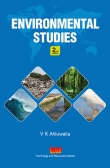Fundamentals of Waste and Environmental Engineering
Book Details
All life forms generate waste. Among them, living beings are the biggest contributors to waste generation. Nature has a limit to which it can treat waste material. When wastes are generated beyond the handling capacity of the nature, it leads to environmental pollution. Atmospheric concentration of greenhouse gases (GHGs) increases with increase in pollutants’ concentration. GHGs are the primary agents of climate change which can have disastrous effects including global warming, change in rainfall pattern, increased glacial melting, sea-level rise, and change in climate extremes. In recent years, e-waste has emerged as a global threat as it contains hazardous heavy metals. All these call for abatement efforts for all forms of pollution by proper disposal of wastes generated.
Fundamentals of Waste and Environmental Engineering deals with the global problem of waste generation. The book also discusses how principles of environmental engineering can be utilized to treat hazardous pollutants to eliminate their ill effects on the environment and how wastes can be transformed into value-added products. In order to make contents applicable, a dedicated chapter on waste generation and mitigation is provided which covers theoretical, numerical, and multiple-choice questions.
Table of Contents
Preface
1. Introduction to Waste and Environmental Crisis
1.1 Introduction
1.2 LHGBRs and Other Life Forms in Relation to Waste Types
1.3 LhgbrDesigns
1.4 Environmental Crisis and Alarms
1.5 Pollution Abatement Needs
2. Water, Wastewater, and Non-aqueous Liquids
2.1 Introduction
2.2 Water Resources, Uses, Pollution, and Purification
2.3 Essentiality of Water
2.4 Wastewater Resources
2.5 Wastewater Treatment Processes
2.6 Waste Feedstocks and Gases Used for the Development of Single-cell Protein Technology by Imperial Chemical Industry
2.7 Non-aqueous Liquid Wastes Volatile Organic Compounds
3. Solid/Semisolid Waste Treatments/Management for Business Developments
3.1 Introduction
3.2 Collection Mode and Their Success Picture
3.3 Sources and Characteristics
3.4 Recycling through Digester
3.5 Ways to Manage Solid Wastes
3.6 Biomass Solid Wastes Reuse/Recycling Routes
3.7 Digestion with Product Gas and Post-treated effluent Recycling
3.8 Two-phase Digestion of Slurry Systems
3.9 Packed-bed Anaerobic Digester
3.10 Technology of Cellulose Processing
3.11 Biomass Conversion as an Alternative Technology for Fuel Production
3.12 Future Aspects of Biomass Conversion Project
3.13 Biotechnoligical Routes for the Provision of Base Chemicals
3.14 Proteinous Biowastes Recycling
4. Environmental Variance and Effects of Pollution on Living Human Genomic Body/Bioreactors
4.1 Introduction
4.2 Quantification Approach of Environmental Variance
4.3 Environmental Variance in the Functions of LHGBRs
4.4 Effects of Environmental Variance on LHGBRs
4.5 Environmental Variance in Relation to Constant Evolution for Biological Evolution
4.6 Environmental Variance-linked Chemiosmotic Disturbance
4.7 Poverty-driven Environmental Variance Effects
4.8 Radical Damage
4.9 Environmental Variance/Climate Change and Global Warming
4.10 India’s Concerns on Environmental Variance and Global Climate
5. Pollution: Parameters, Abatements, and Treatments
5.1 Introduction
5.2 General Concerns and Principles
5.3 Biodepyritization Strategies
5.4 Bioremediation Reactor Studies
6. Air Pollution and Its Abatement
6.1 Introduction
6.2 Air Pollution: Causes, Sources, and Hazardous Effects
6.3 Major Contributors to Air Pollution
6.4 Technologies for Abatement of Air Pollution
6.5 Air Pollution Control
6.6 Pollution-free Air Supply
6.7 Climate Change Concerns
6.8 Noise-polluted Atmosphere
6.9 Dual Effect of Air Pollutants
6.10 Healing by Nanoparticles
7. Wastes to Value-added Products
7.1 Introduction
7.2 Bioenergy from Biowastes
7.3 Biotechnology, Chemical Technical, and Biotechnology– Chemical Technology Integrated Processes
7.4 Value-added Products from Wastes
7.5 Bio-hydro Metallurgical Extraction of Metals from Low-grade Ores
7.6 Enzyme and Microbial Technology
8. Waste Heat Treatments and Utilizations
8.1 Introduction
8.2 Attributes of Waste Heat Water
8.3 Potential for Improvement of Heat Pumps
8.4 Predicting Heat Pump Performance
9. Theoretical, Numerical, and Multiple-choice Questions on Wastes and Treatments
9.1 Introduction
9.2 Wastes and Treatments
9.3 Numerical Problems on Wastes and Treatments
9.4 Numerical Problem on Air Pollution
9.5 Multiple-choice Questions
Appendix
Index
You may also like...
-
 Environmental Studies (Second Edition)
Regular Price 325.00
Special Price 293.00
Environmental Studies (Second Edition)
Regular Price 325.00
Special Price 293.00
-
 The Land of the Setting Sun & Other Nature Tales
Regular Price 250.00
Special Price 225.00
The Land of the Setting Sun & Other Nature Tales
Regular Price 250.00
Special Price 225.00


